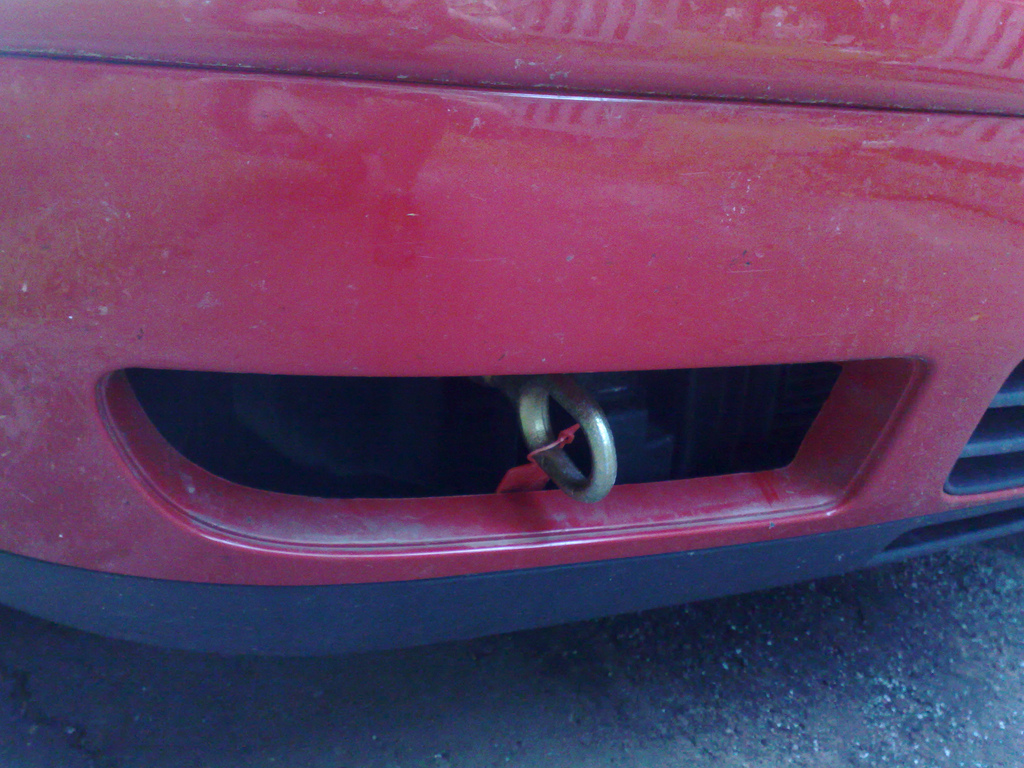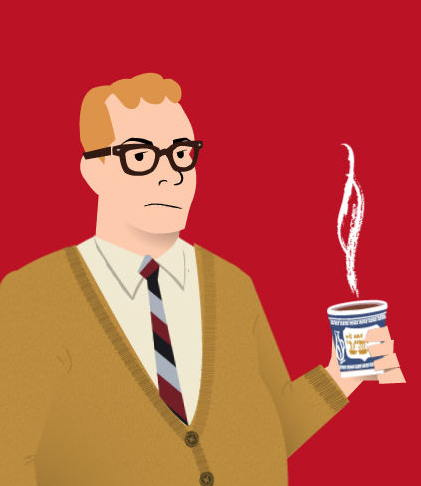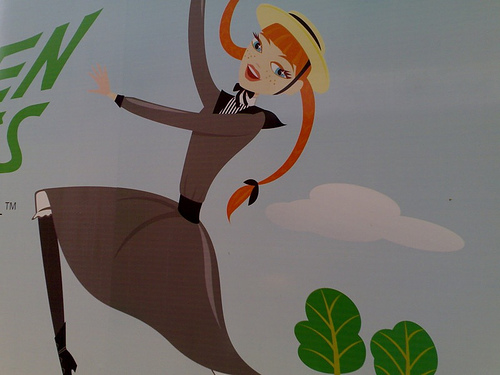On Friday I was working on securing my canoe to the roof of my 2000 VW Jetta. When I got around to tying down the front, I was surprised to find that there was no “tow hook” on the front at all. I consulted the manual for the Jetta only to find that I’d “archived” the section on towing somewhere. Fortunately some web searching revealed that the Jetta does have a tow hook, you just have to install it. Here’s how.
First, open up the trunk of the car, empty its contents, and lift up the panel that covers the spare tire. Tucked inside the styrofoam that secures the car jack you should find a round bronze-coloured screw-in tow hook:

Now, move around to the front of the car. On the left-hand side (passenger’s side) you’ll see, under the bumper, a vent-like plastic piece like this:

Stick your hands into the vent and you’ll see that you can grasp it enough to gently snap it out of place:

Underneath you’ll find that there’s a place for you to screw in the tow hook. Note that it’s reverse-threaded, so you screw it in the opposite direction to the way you normally screw things in. Here’s what you’ll have when you’re done:

Unfortunately there’s no place the screw-hook on the driver’s side of the car; as the Jetta’s rear tow hook is also on the passenger’s side, this means that any canoe-securing ends up somewhat lop-sided.
When Oliver was two years old we shared a Coca-Cola with a bunch of Thai prostitutes on a restaurant patio in Chiang Mai. When he was three years old we spent two weeks in Spain where our evening routine consisted of tapas at 4:00 p.m., drinks at 6:00 p.m. and supper at 10:00 p.m., much of this conducted in smoky, boozy, lively places. When he was five years old we spent a month in France, and on our first night we ate supper at a soulful pizza place in Orleans where a drug deal was going down at the next table over. When Oliver was eight years old we spent a transcendent night in a café in Paris where much wine was consumed, to the point where it fell on his wee shoulders to walk me home to the hotel.
As near as I can tell, despite his late-night boozy, smoky, prostitute-filled childhood, Oliver has top-flight morals, and is no more likely to lie, cheat, or steal than the next guy. I would perhaps even say that because of his late-night boozy, smoky, prostitute-filled childhood Oliver has a greater appreciation for the richness of the human experience, and as a result is a wiser, more rounded person that he would have been if he’d been kept cloistered.
And yet tonight.
Tonight we — Catherine, me and Oliver — decided to go down to the Churchill Arms, a curry pub around the corner from our place, for dinner. It was getting late — just after 8:30 p.m. — but we were all hungry and tired after an afternoon of canoeing in Johnstons River.
Alas the visions of butter chicken and chips dancing in our heads were dashed when we were told that Churchill Arms’ liquor license wouldn’t allow minors on the premises after 8:00 p.m. They were very nice and apologetic about it, and of course it’s a matter outside of their control so we bid them no ill will.
But. Come on. It’s 2009.
What did we do instead? Walk 3 blocks up and 1 block over and ate at the Alibi Lounge.
They have a liquor license too, but their license allows minors on the premises until 10:00 p.m. Why this was any less corrupting of Oliver’s morals than watching the same alcohol being consumed a few blocks away, I cannot explain.
Our experience at the Churchill tonight echoes a similar experience from two years ago. We are longtime Lennie Gallant fans, and when a visit from my parents coincided with a Lennie concert at the Silver Fox Curling Club in Summerside, we got tickets for the whole family. On the appointed night we arrived to pick up our tickets, Oliver in tow, and were told that Oliver couldn’t join us as it was a “licensed event.”
Prince Edward Island does have a rather tortuous relationship with the demon alcohol. There were prohibition plebiscites in 1878, 1893, 1898, 1901, 1923, 1929, 1940, and 1948. It was only the last one that saw prohibition come to an end. Well, at least partially. We still have a 17,000-word Liquor Control Act along with 15,000 words of associated regulations, that together are, as our experiences suggest, a very complex web.
In there you’ll find, among other things, clauses allowing doctors, dentists and veterinarians to be issued permits to dispense alcohol, a definition of liquor that includes, among other things, “any other liquid that is intoxicating,” descriptions of the 12 classes of liquor license allowed (club, dining room, military canteen, lounge, brewer’s, special premises, caterer’s, winery, tourist home, distiller’s, brew-pub and micro-brewery), a prohibition against counters and stools in dining rooms (along with an associated requirement for table-cloth use), and requirement for tourist home license holders to provide “personalized hospitality.”
And that’s only a thin slice of the hard-core needless draconian overkill that we’ve constructed around the serving of alcohol in Prince Edward Island.
Prohibition may have given way 61 years ago, but its vestiges live on. While the over-the-top parts of the regulation of alcohol have been chipped out of the act over the years, and while modern innovations like “wineries” have been allowed to operate recently, the substantive core of the Island’s official stance on alcohol is, essentially, “this stuff is bad for you, and we’re going to make it really, really difficult and complex for it to be sold, just to drive this point home.”
Does anybody really think that’s still a good idea?
So here’s my idea. Throw the Liquor Control Act away. All of it.
Continue to tax alcohol, but let anyone sell it. Any time of the day. With any degree of hospitality. With the option of having counters and stools if they like. One class of license, for tax-collection purposes only. Leave the morality right out of it. Drinking and driving is still against the law, as is serving alcohol to someone who’s obviously too drunk to have any more.
I’ll bet I could pen up a set of laws that would fit on a single sheet of paper that would make almost any reasonable person comfortable. And I’ll bet that when Pete’s Go Wild with Alcohol Act passes the morals of Prince Edward Islanders will be as intact as they were before.
Am I missing something?
For the past 18 months my day-to-day mobile phone has been a Nokia N95. When I bought the phone it was the top-of-the-line device from Nokia and while I’ve generally been happy with the phone, it’s showing its age and I’m looking at alternatives.
The Series 60 user interface of the N95, once the cat’s pajamas of mobile UI, seems needlessly complicated and clunky now that we’re in a touch-screen world. While I was once happy to put up with bugs and irregularities because the device was “bleeding edge,” things like the address book crashing once in a while, are increasingly frustrating. And when a recent firmware upgrade — the first in over a year — ended up introducing more bugs and irregularities (like the need for a hardware reset when trying to access a just-out-of-range WLAN), my frustrations only increased.
I feel like the N95 has been abandoned by Nokia, and thus I feel abandoned as a customer by Nokia, so I’m thus much less inclined to look at things like the Nokia N97, which has replaced the N95 as Nokia’s top-end phone.
By way of sussing out the alternatives I’ve been carrying my iPod Touch, as a stand-in for an iPhone, in my other pocket every day, and using it to run the sort of mobile applications I’d otherwise run on the N95. So instead of Profimail I’m using the built-in iPod mail client, instead of Gravity I’m running Tweetie, instead of Nokia Podcasting (that stopped working completed after the firmware “upgrade”) I’m using iTunes (or at least half-using it, as the mobile iTunes doesn’t support over-the-air subscriptions), and instead Nokia’s built-in web browser (never a joy), I’m using Mobile Safari.
I’ve also added in some applications that aren’t available on the N95 at all: Instapaper, Stanza and Byline for reading, and OffMaps and Google Earth for mapping.
After a few weeks of experimenting this way, here’s where I’m at:
- The most maddening aspect of the N95 has always been it’s wifi-handling (or rather mishandling). The notion that I need to select an “access point” for every application I start, even if I’m already online with another application, is clunky and somewhat bizarre. While there are, in theory, add-ons like Devicescape that make this process easier has never really panned out for me: while they make logging in to secure access points easier, they don’t solve the underlying issues. The iPod Touch, by contrast, handles wifi brilliantly: you turn it on, and it works across all applications, and auto-connects to access points you’ve used before. The only downside is that if you leave wifi connected on an iPod Touch overnight it’s likely that its battery will be dead by morning. +1 for Apple.
- I’m not convinced that the “screens of scattered icons” user interface used by the iPod Touch and the iPhone is best for me: I get confused by which application is which, and all applications being “equal” but for their icon position and design doesn’t offer enough for my brain to quickly be able to pick out what I need. That there is a Music application to listen to music and an iTunes application to buy music and download podcasts only makes this doubly confusing, given that it’s the iTunes application on my laptop that does both. While the N95 uses a similar approach, it at least supports folders of application so I can apply some hierarchy to the organization. +1 for Nokia.
- The iPod Touch has two buttons: an on/off button on the top, and a single round button under the touch screen. By contrast the N95, in addition to the numeric keypad, has 14 buttons (I had to count), and while my fingers have become accustomed to their functions by now, there’s a steep learning curve, and something I’m still not sure which button I’m supposed to press. +1 for Apple.
- Enforcing user interface guidelines is something Nokia has never particularly excelled at: even with applications the Nokia itself creates there are a seemingly endless number of user interface toolkits in rotation, and an application like Nokia Sports Tracker looks and feels completely different from something like Nokia Internet Radio. There’s more UI unity on the iPod Touch, but in a way this only makes things more maddening when inconsistencies appear: there are two different ways of “deleting items on a list of things,” for example: in the Mail application it’s “Edit, Select, Select, Select, Delete” whereas in Instapaper it’s “Edit, Select, Delete, Select, Delete.” Draw.
- When it comes to syncing my calendar and contacts, it’s a draw: both the N95 and the iPod work well with iCal and Address Book on my Mac via iSync and iTunes. Similarly, Nokia Multimedia Transfer does a good job at handling photo and music syncing with iPhoto and iTunes. Draw.
- The iPod Touch doesn’t have a camera, so I don’t have anything to contrast to. The camera on the N95 has always been a standout feature for me: it’s takes nice 5 megapixel images, has a very solid macro mode, and the onboard photo management and editing capabilities have always been enough for my needs. Setting as the occasional need to reformat the internal memory card to prevent videos from stuttering, the video camera in the N95 is similarly nice, and it’s nice that I can shoot videos like this with a camera that fits in my pockets. +1 for Nokia, but perhaps the iPhone will work just as well?
- While it’s hard to argue with the ease-of-use of Apple’s App Store for finding and installing applications — it makes Nokia’s Ovi Store seem like a Commodore 64 application — the notion of there being a single conduit through which applications must flow to the device is anathema to me. That said, while the N95 is, in theory, more “open” to applications — I can install apps from any source, either over the air or from my PC via Bluetooth or USB cable — the inane Symbian Signed process that requires all applications to be digitally signed to be able to access capabilities of the device has always been a significant barrier, especially for open source applications. It’s great, for example, that Nokia released Python for the N95, less great that you need to use the complicated signing process to really take advantage of it (which effectively nullifies the notion of distributing Python apps for the N95 to a broader audience). +1 for Nokia, with a footnote.
- I bought my N95 factory unlocked, meaning that I can use it with any carrier simply by swapping in a new SIM card. This is a big deal for me when I travel: it means I don’t have to pay exorbitant international roaming fees and can, instead, purchase a low-cost prepaid SIM card for whatever country I happen to be visiting. The iPhone, by contrast, is locked, here in Canada, to the Rogers network (although in theory it can be “jailbroken” to unlock it). +1 for Nokia.
It’s those last two points – the notion that having an iPhone locks me to Apple for my applications and to Rogers for my service – that are particularly distasteful to me, and that, in fact, might be iPhone deal-breakers. My next move is to consider the Palm Per (presumably suffering from a similar locked-to-Bell problem), or one of the Google/Android phone. Or maybe I should just give up this mobility silliness and go phone free?
You may recall that when the calendar struck 10 on this blog, y’all in the readership had contributed 17,987 comments on the posts here. When I flipped the switch over to Drupal, those comments got temporarily left behind. I’m happy to announce that the comment are now back in their proper place, and you can relive old chestnuts the the 347 comments on Tim Hortons Responds and the 222 comments on WigWag Bar from the Tuck Shop.
Through series of happenstance events that started with a tweet from my Dutch friend Elmine, I’ve been accepted as one of 81 participants from around the world to participate in round number two of the European Blogging Competition (insert joke about “typing really really fast” here).
The competition involves a three month commitment to blog about climate change on the Think About It website. And, somewhat ironically, it kicks off with all 81 participants flying into Copenhagen for a two-day launch event (insert wry ironic comment about flying across the ocean to blog about climate change).
The allure of getting to hang out with an international crew of 81 bloggers, combined with the usual allures of Copenhagen, my favourite city, were enough to get me over my misgivings about competition (blogging — competitively!?) and to try to rationalize the whole “causing climate change to blog about climate change” travel thing. In this regard the words of Edward Hasbrouck proved some comfort:
But I haven’t stopped flying. I continue to believe that long-haul travel, even by air, can in particular cases have a net positive effect on the world, mainly through the secondary effects of the permanent changes it can bring about in our worldview, which result in changes in how we go on with our lives.
It’s at least something to hang my hat on.
That said, it did seem absurd to fly to Copenhagen from Canada for two days, so I’ve arranged to extend my trip to 10 days, at my own expense, to at least spread the travel over a longer period of time.
My next travel grapple is related to SHiFT, the Lisbon conference being organized by my Portuguese friends in mid-October. I’ve been planning to go to SHiFT every year it’s been held, and it’s never worked out (last year we happened to hold Zap Your PRAM on the same weekend, which had the additional downside of keeping Zap a Portuguese-free event).
I was inspired to think more deeply about the implications of going to SHiFT by my friend Henriette, who’s launched the shift09 DIY transportation crusade around her own plans to skip flying and take a 41-hour train trip from Copenhagen to Lisbon.
In the end, there’s just no practical way of getting across the Atlantic ocean that doesn’t involve flying.
I looked into the possibility of taking the October 9th sailing of the Queen Mary 2. I’d have to get myself to New York City, and then from Southampton to Lisbon on the other end, it would cost me about $1,200 each way, and I’d have to be prepared to spend 12 days at sea in total. All that and it’s not clear that cruising is any less harmful, climate-change wise, than flying.
There’s the possibility of hitching a ride on a freighter cruise, which would be a little cheaper and perhaps someone more environmentally friendly given the lesser degree of opulence. But that seems to involve even more time at sea — up to two weeks in either direction — and I simply don’t have that amount of time to spend away from my family and away from work.
Then there’s the more obvious solution: combine the September trip to Copenhagen with the October trip to Lisbon, and join Henriette on her 41 hour journey of hope. I’ve considered it, believe me. But that would involve missing Oliver’s 9th birthday, skipping out on the Access 2009 conference that I’m both helping to organize and am scheduled to speak at, and, in the end, being away from home for more than a month.
Of course the most obvious solution is just not to go to SHiFT at all, and as much as the prospect saddens me, I’m considering that too.
If I do decide to go on a planet-destroying two-trips-to-Europe-in-a-month I will, if nothing else, have a lot to write about during my three month rumination about climate change.
Because I’m a fan, and because I appreciate the app, I will play along. Here’s my Man Men self. Note that I opted for a “realistic” design rather than an “aspirational” one: that’s why I look more like Lou Grant than George Clooney. Oh the 60s, what a crazy time.

Okay, I give up. Both Oliver and my mother have expressed discontent with FD Helwoodica, so I’ve swapped it out in favour of a more traditional Helvetica — i.e. one not scanned from woodcut prints.
The other night I found myself on the couch with Oliver around bedtime needing something to read as a bedtime story (the heat and humidity sapped my ability to make up another original “Yarky the Yak” story). I found my iPod Touch within arm’s reach — and important criterion — and fired up the Stanza e-book application, poked around for a while and finally ended up downloading the Project Gutenberg version of Anne of Green Gables. Two minutes later we were learning about that busybody Mrs. Rachel Lynde.

Having lived in Prince Edward Island for 16 years, I’ve had a significant exposure to the Annedustry (a term I believe I have just coined).
It’s difficult to avoid. I live 500m from Anne’s nightly musical rampage. I used to work for the Anne of Green Gables Store as a product developer (my great accomplishment was developing a line of Anne-themed jams and jellies). I wrote the original business plan for what later became Avonlea Village. I used to advise the Anne of Green Gables Licensing Authority on domain name issues. I’m the president of the L.M. Montgomery Land Trust, which has a missing of preserving the heritage landscapes the inspired L.M. Montgomery in the first place. Heck, in grade 3 at Balaclava School in Ontario I was in the chorus of the school’s go at the musical.
Me and Anne, in other words, we’re pretty tight.
And yet, in all those years, I’d never actually sat down to read the book. Until this week. And you know what? It’s pretty good.
Of course we’re only two chapters in — last night at 11:00 p.m. Oliver couldn’t sleep and so I pulled Matthew Cuthbert is surprised out of my pocked to calm him down — but Montgomery obviously has a way with the language, and Prince Edward Island does come off looking pretty good:
They had driven over the crest of a hill. Below them was a pond, looking almost like a river so long and winding was it. A bridge spanned it midway and from there to its lower end, where an amber-hued belt of sand-hills shut it in from the dark blue gulf beyond, the water was a glory of many shifting hues — the most spiritual shadings of crocus and rose and ethereal green, with other elusive tintings for which no name has ever been found. Above the bridge the pond ran up into fringing groves of fir and maple and lay all darkly translucent in their wavering shadows. Here and there a wild plum leaned out from the bank like a white-clad girl tip-toeing to her own reflection. From the marsh at the head of the pond came the clear, mournfully-sweet chorus of the frogs. There was a little gray house peering around a white apple orchard on a slope beyond and, although it was not yet quite dark, a light was shining from one of its windows.
It’s easy to be snide about Anne and the narrow lens through which an Anne-centred tourism industry casts Prince Edward Island. But it’s important, I’m learning, not to cast out everything Anne as kitsch either.
A tip from friend-of-the-blog and longtime reader Valerie: there’s an outfit in Morell called Kingfisher Outdoors, based in the Morell Welcome Centre, that rents kayaks for use on the Morell River. You can park your car in Morell, they’ll shuttle you up-river, and you kayak back to Morell, which takes, they say, about 2 hours.
They charge $50 per trip for a double kayak, $30 for a single kayak, and there’s a $20 shuttle fee for parties smaller than four. They suggest calling to make a reservation the day before you want to take your trip — you can reach them at (902) 961-2080 and they’re open from 9:00 a.m. to 6:00 p.m.
While we’re waiting for our canoe blocks to arrive, we might just take a run out to Morell and give them a try.
 I am
I am